
A Dreamy Island Getaway
From Athens to Sifnos—Greece Serves Up Ancient Perfection in the Aegean
By Sandra K. Woodward | Photography by Richard Woodward
If you have long dreamed of a trip to the Greek islands, the good news is there is an overabundance of choices—from tiny, sparsely populated specks that could almost be classified as mere rocks to the other extreme of the large islands characterized by high population and major urban areas. Such variety allows the traveler to create an experience to fit even the most exacting specifications. Do you want a party island, where the nightlife never ends? A family vacation with beaches where young children can play safely while parents relax? Do you want to focus on exploring ancient ruins that evoke the Greece of museums? How about a hiking holiday, with spectacular vistas and challenging trails? The reality is that the islands of Greece offer the opportunity to explore each of these activities and more—and many offer all of them in one place.
The challenge in planning a Greek island vacation is the process of elimination. Finding the island that fits your personality and your travel goals can be a large part of the fun. On the other hand, who’s to say it wouldn’t be as much fun to close your eyes and pick an island—or several—on the map? Such a bold gesture reflects the spirit of adventure and romance that are almost requirements for those who choose to visit Greece and its islands. The very best news is that it’s hard to go wrong. Whatever your choice, you will be on an island—in Greece!
Any journey to the Greek islands should begin with a stop in Athens. Not just the capital of Greece, Athens is one of the most important points of origin for all of Western civilization, and that history pervades the city at every turn. Round a corner and catch a glimpse of the Parthenon high atop the Acropolis. Stroll the Ancient Agora, or market square, where Plato, Socrates, and other great minds debated the tenets of philosophy, government, mathematics, and science. Even a trip on the city’s excellent metro system is a journey back in antiquity, with display cases in four of the city’s metro stations exhibiting ancient relics such as water jugs, coins, and even a gravesite, all found during excavation for the underground tracks.
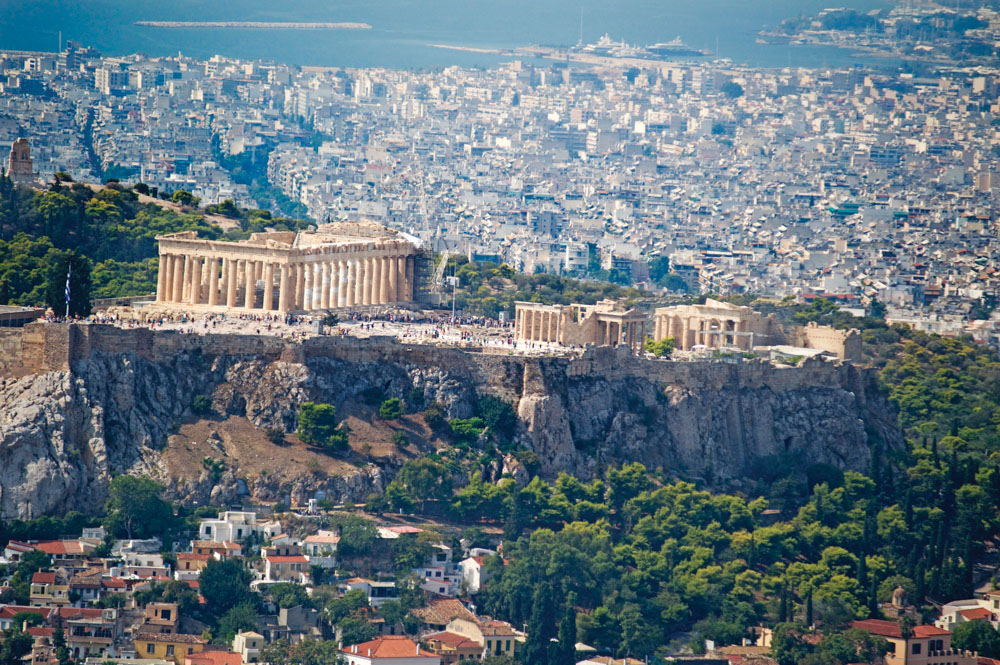
A visit to the new Acropolis Museum, completed in 2007, is well worth the investment of a day’s time. While nothing can replicate the firsthand experience of a trip up to the Acropolis itself, this world-class museum does an extraordinary job of enhancing one’s visit to the ancient ruins and providing extensive interactive educational activities for visitors of all levels of knowledge. The architecture of the building is a perfect setting for the treasures it houses. The glass walls offer astonishing views of the Acropolis itself, a brilliant blending of past and present. Even the museum’s website, www.theacropolismuseum.gr, is exciting and innovative. As preservation work on the Parthenon and other buildings atop the Acropolis continues, the museum offers detailed explanations of the history and evolution of the site and three-dimensional views of its many antiquities, many never visible before. The exhibition of the Caryatids of the Erechtheion is a case in point. Five of the six magnificent female forms that have stood since 421 BC were moved to the museum for cleaning and restoration using sophisticated laser technology. The sixth was separated from her sisters and removed to England by Lord Elgin in the early nineteenth century, along with other treasures from the Acropolis now on view in the British Museum. Greece has long lobbied for the return of the Elgin marbles to the Acropolis, but the British authorities argued that there was no appropriate location for their protection and preservation. The new museum and its superb facilities would seem to negate that argument, and Britain can expect continued pressure for the return of Greece’s precious antiquities.
Consider the Athens stopover a period of indoctrination into the Mediterranean mentality. From the quiet, sedate (wealthy) neighborhoods of Kolonaki nestled at the foot of the city’s highest point, Mount Lycabettus, to the buzzing, never-seems-to-sleep vibe of Monastiraki and the Plaka, areas where Athenians and indeed visitors from around the world have always congregated, this is a vibrant, modern city with an infectious joie de vivre, replete with high-end stores, coffee shops, bars, and restaurants ranging from the most humble souvlaki stands to the most sophisticated fine dining. Dining alfresco is the norm, with even the tiniest café offering a couple of sidewalk tables. The early September weekend of our visit was shared with what appeared to be all the citizens of Athens relishing the many outdoor restaurants in a most convivial atmosphere.
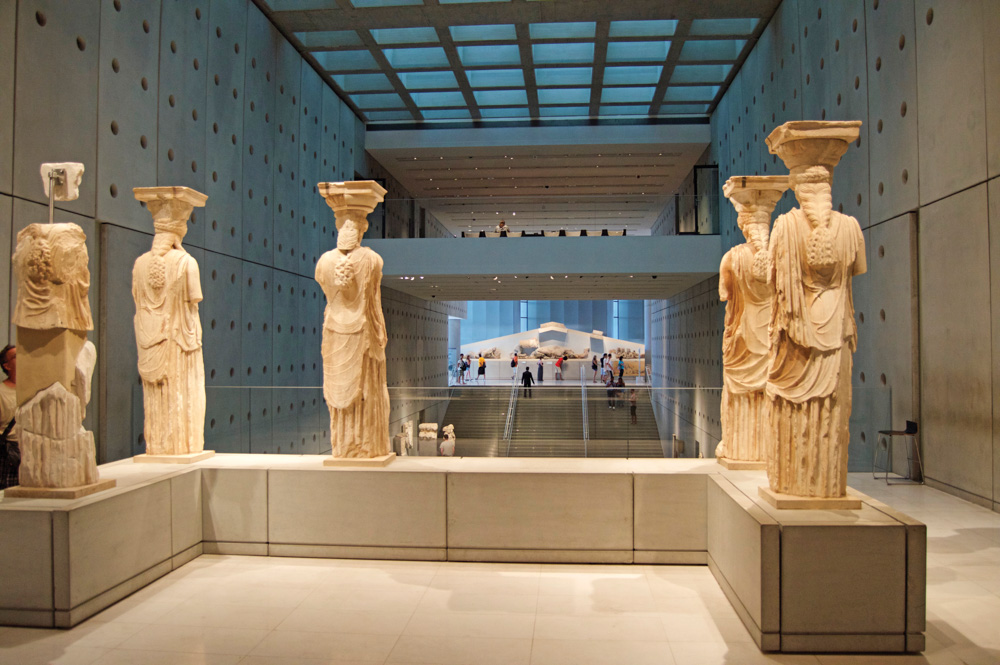
Athens is stimulating, but island life was the real reason for our visit, and it was time to see if dreams would match reality. On Sunday at midday, we joined throngs of metro passengers headed for the port of Piraeus and the outbound ferries. The term “throngs” is relative. One of the best reasons to choose September for a Greek island visit is that most Athenians and other Greek residents take their annual holidays in July and August. By September, the crowds have thinned significantly, but the majority of restaurants and attractions are still open until the end of the month, when proprietors return to their homes on the mainland or farther afield.
Nowhere on Sifnos is the sense of history greater than in the ancient citadel village of Kastro, the former capital of the island and the oldest continuously inhabited village, dating back to the prehistoric third millennium BC.
For my husband and me, the objective of traveling is to be, not to do. Rather than checking off every site listed in a guidebook, we prefer the leisurely approach to getting to know a new locale, its people, history, and culture. We stroll. We sit. We drink coffee or wine. We chat. Our chosen destination, Sifnos, in the western Cyclades, was the perfect match for us in size, scope, and ambience. Its thirty-five square miles comprise several population centers connected to each other and to more remote areas by a network of quite good roads for car or motorbike rentals, a well-used bus system, and taxi services, making the entire island accessible. With a year-round population of only about 2,200, the island is not crowded once the high summer season is over, a plus for our planned September visit. There are a wide variety of accommodation choices, from simple seaside cottages renting single rooms to hotels, secluded in-town apartments, and a couple of rather high-end resorts. Finally, Sifnos is a center of rich history and culture. In all, the island offers an environment that is friendly, welcoming, and fresh to even the most jaded traveler. One further note: We limited our visit to one island only. If exploring several islands is your goal, be sure to examine ferry schedules carefully; not all islands are accessible directly from each other, ferries may not run daily, and connections may require an overnight stay.
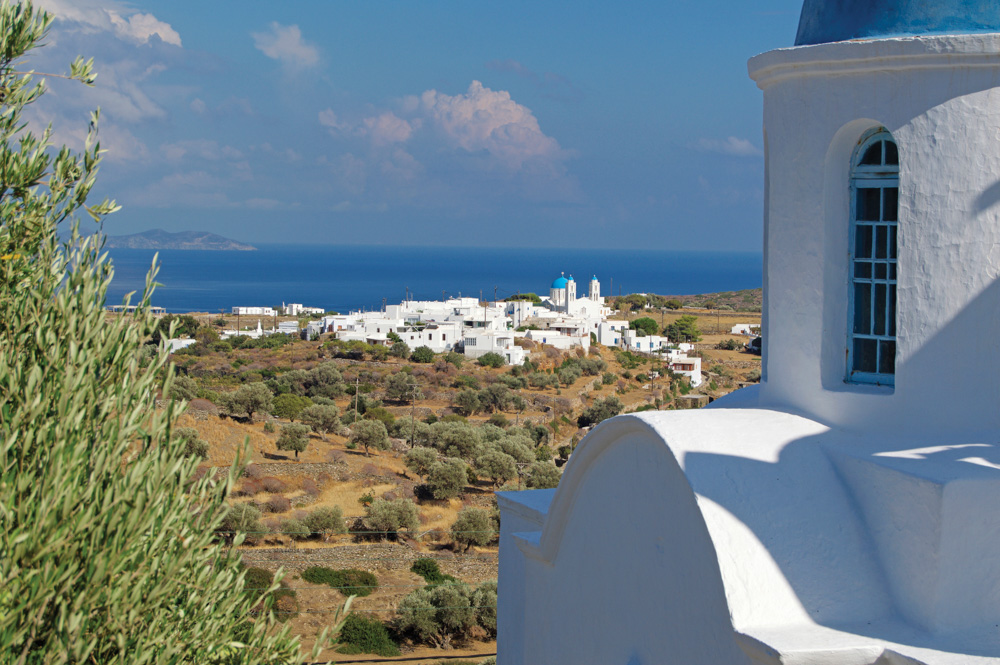
On Sifnos, the combination of an average September temperature of 73 degrees Fahrenheit and little rainfall ensures many hours of basking in the Aegean sun, whether sitting on the patio of a taverna sipping ouzo or one of the excellent local wines; swimming in the warm, crystal clear waters of the Aegean; or visiting some of the more than 360 churches that dot the island from sea level to the highest point of 2,228 feet. Spectacular vistas, warm breezes fragrant with wild thyme, the cobalt sea in the distance, and sugar-cube architecture embody the ideal of a Greek island vacation. But that’s just the beginning.
Each major area of the island offers the visitor a unique experience. Since there is no airport, arrival by sea is the only option, and the introduction to the island and its culture begins for most travelers in the port of Kamares. While there are several ferry companies to choose from, we chose the Aegean Speed Lines Speedrunner fleet, featuring spacious and comfortable vessels and a fast three-hour Athens-to-Sifnos run. Speed was the order of the day, with the ferry disgorging people and vehicles onto the dock in record time, making us very happy that we travel with only one airline-friendly carry-on suitcase each.
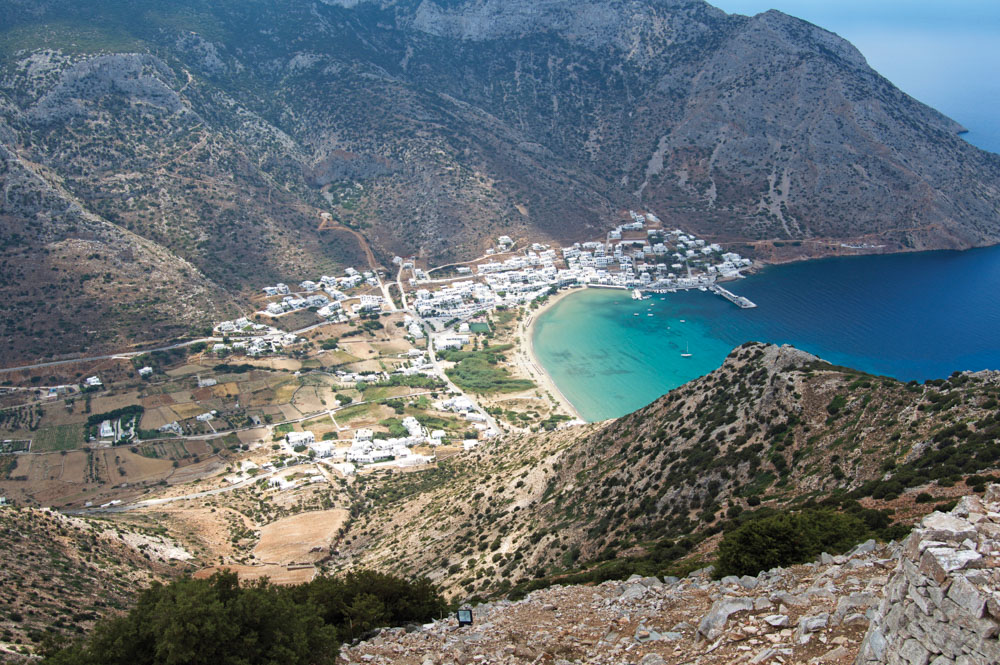
First impressions do matter, and Kamares, with its tidy waterfront (including clean public restrooms) and geranium- and bougainvillea-bedecked hotel balconies, offers a friendly welcome. For us it was a quick hello. We headed directly for the Hotel Stavros, where we met Stavros Kalogirou, who with his British wife, Sarah, owns two hotels in Kamares and the Eleonas Apartments in Apollonia, where we had chosen to stay. His informal generosity reinforced the warmth and kindness we had felt from the e-mail exchanges with Sarah in planning our trip, and we picked up our rental car—a small Fiat Panda, the perfect size for maneuvering on the sometimes narrow, winding roads of the island—and followed Stavros to the capital of Apollonia and our home for the week.
The Eleonas Apartments are relatively new, nestled in a grove of olive trees, and arranged for maximum privacy, although only steps away from the heart of the town. Our patio was directly adjacent to Panagia Ouranofora, an eighteenth-century church said to have been built from stones from the seventh-century BC temple of Apollo, for whom the capital is named.
Spectacular vistas, warm breezes fragrant with wild thyme, the cobalt sea in the distance, and sugar-cube architecture embody the ideal of a Greek island vacation.
The Eleonas Apartments are relatively new, nestled in a grove of olive trees, and arranged for maximum privacy, although only steps away from the heart of the town. Our patio was directly adjacent to Panagia Ouranofora, an eighteenth-century church said to have been built from stones from the seventh-century BC temple of Apollo, for whom the capital is named.
Apollonia is the throbbing heart of Sifnos. It is the busy crossroads for bus, car, motorbike, and taxi traffic and is the municipal and financial center of the island, the location of the post office, and a primary center for shopping. It is home to the Sifnos Folklore Museum, and it is also the focus of much good food. The steno (translation: alley) is a narrow pedestrian street that snakes uphill from the town square, crowded with shops and restaurants serving many traditional favorites, from the cold caper salad at O Drakakis to the freshest grilled lavraki (sea bass) at Apostoli to Koutouki and the loukoumades, doughnut-like fried pastries drizzled with honey or chocolate at Three Blond Angels.
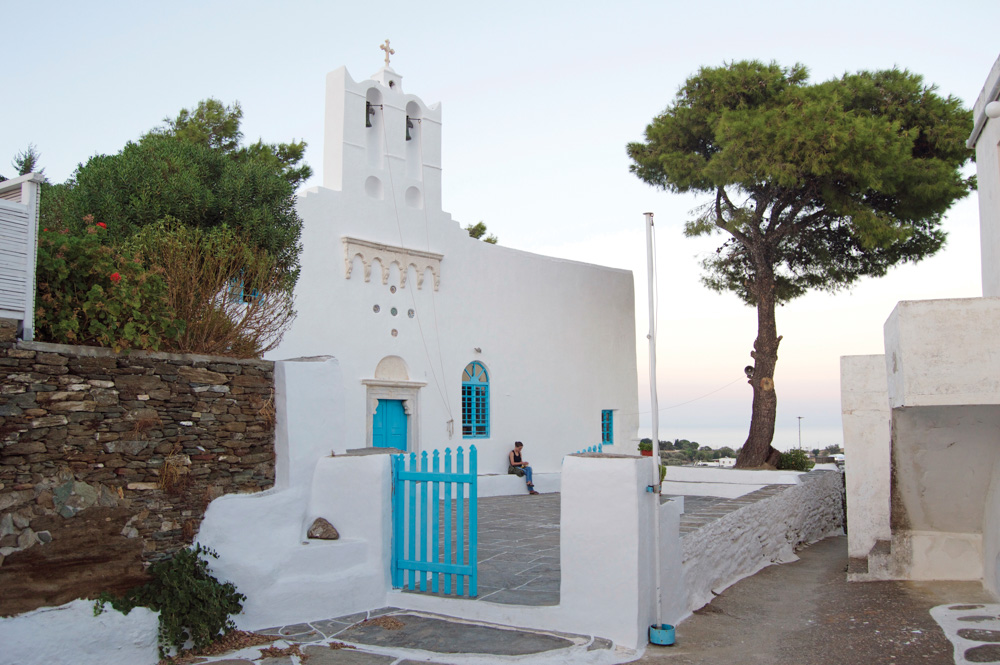
Greece’s most famous chef, Nikolaos Tselementes, was a Sifnian who codified the traditional recipes in the first-ever Greek cookbook around 1910. An annual culinary festival in his honor is held each September in Artemonas, a charming twenty-minute walk uphill from Apollonia through a winding, narrow pedestrian-only stone walkway—but also easily accessible by car via the main highway. The buildings fronting the immaculately paved stone pathway are iconic Greek island architecture: blindingly white structures trimmed with as many shades of blue as the changeable Aegean or, like our apartment, a signature pale green evocative of the island’s shallow coastal waters. Tiny well-maintained gardens offer accents of brilliantly colored flowers or the welcome shade of pomegranate trees.
Sifnos is also known for its pottery, and Artemonas features studios offering locally produced wares. More potters are scattered across the island, many of them displaying the signature clay chimney pots found atop many homes on the island. Perhaps the best-known potter is the elderly Kostas Depastas, who works in a primitive studio in the seaside village of Cherronisos, where he still gathers wood from the surrounding hillsides to fire his kiln and digs local clay to make his pots. An impromptu visit to his studio was one of our most rewarding experiences on the island. Although it was the only time we encountered any language barrier, our appreciation for his craft and his willingness to welcome strangers transcended any minor miscommunication.
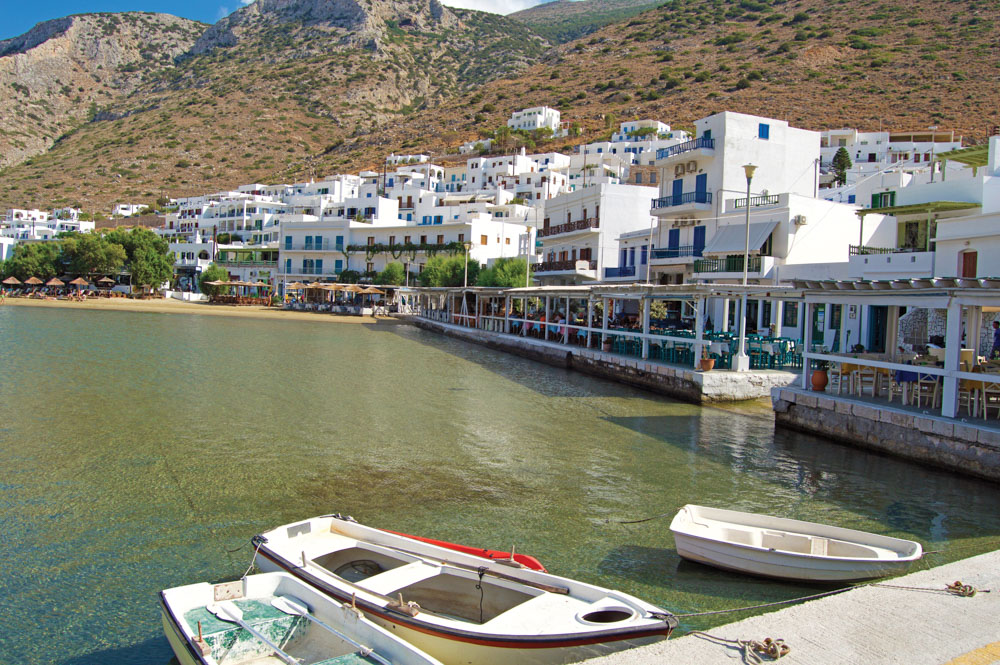
Beautiful Beaches
Tiny Cherronisos is only one of the many renowned beaches on Sifnos. Vathi, considered by many to be the most beautiful beach on the island, is the site of a new development, Elies Resorts. The road to Vathi offers the added value of the archaeological site of the Mycenaean citadel of Agios Andreas, dating back at least to the twelfth century BC. The views from the top of the site are among the most spectacular on the island. Nearby Chrissopigi/Apokofto beach is a bit quieter, in September at least. The beach is wider than some and a favorite for boaters who drop anchor far enough offshore so as not to pose problems for swimmers or sunbathers. Though only a short stretch of sand, it supports two tavernas with spacious covered patios offering respite from the sun. It is also home to the popular Sifnos Diving Center.
Close by, Faros comprises three beaches and the starting point of a footpath that winds around the cove to Panagia Chrissopigi, one of the most spectacular churches on the island. We began our exploration of the footpath at dusk one evening, sharing the path with a herd of goats grazing in the vegetation beside the path in complete disregard of our presence. Their tinkling bells adding a lovely musical accompaniment to our walk. We stopped to rest midway in the deserted terrace of yet another church, where we were joined a few minutes later by a young couple from Thessaloniki who told us they were planning to marry next year. They were considering a wedding at Panagia Chrissopigi and were on their way to see the picturesque church in the light of the full moon. Thanks to the charming presence of our four-legged companions, the beautiful setting, and the young couple full of such sweet plans for their future, we will always treasure that magical evening!
The Eleonas Apartments are relatively new, nestled in a grove of olive trees, and arranged for maximum privacy, although only steps away from the heart of the town. Our patio was directly adjacent to Panagia Ouranofora.
Nowhere on Sifnos is the sense of history greater than in the ancient citadel village of Kastro, the former capital of the island and the oldest continuously inhabited village, dating back to the prehistoric third millennium BC. Expect to climb many steps in order to explore Kastro fully, from the top of the citadel and the walkway that follows the old wall facing east to perhaps the most photographed spot on the island, the Church of the Seven Martyrs, which crowns a rocky headland above the sea. Kastro offers many spectacular views, fine examples of well-preserved island architecture, tavernas, and shops. Here, to commemorate Sifnos as the site of perhaps the world’s first silver mine, we bought a few fine pieces of silver jewelry from Maximos, an Athenian jewelry designer who summers in Kastro. Perhaps one day these pieces will be passed down in our family along with the stories we tell of our visit, so that the siren song of Sifnos will be heard by future generations.
Our week on Sifnos exceeded all our expectations for a Greek island vacation. What it did not do was quench our desire to visit this beautiful part of the world. Instead, we are narrowing down our choices for our next adventure. So many islands, so little time.
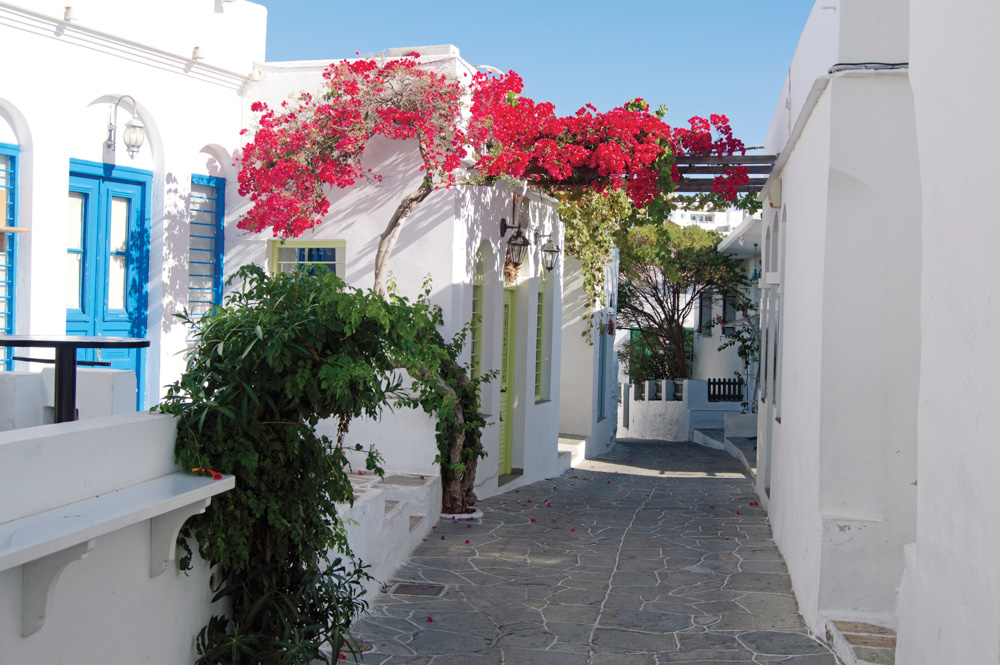
Nowhere on Sifnos is the sense of history greater than in the ancient citadel village of Kastro, the former capital of the island and the oldest continuously inhabited village, dating back to the prehistoric third millennium BC. Expect to climb many steps in order to explore Kastro fully, from the top of the citadel and the walkway that follows the old wall facing east to perhaps the most photographed spot on the island, the Church of the Seven Martyrs, which crowns a rocky headland above the sea. Kastro offers many spectacular views, fine examples of well-preserved island architecture, tavernas, and shops. Here, to commemorate Sifnos as the site of perhaps the world’s first silver mine, we bought a few fine pieces of silver jewelry from Maximos, an Athenian jewelry designer who summers in Kastro. Perhaps one day these pieces will be passed down in our family along with the stories we tell of our visit, so that the siren song of Sifnos will be heard by future generations.
Our week on Sifnos exceeded all our expectations for a Greek island vacation. What it did not do was quench our desire to visit this beautiful part of the world. Instead, we are narrowing down our choices for our next adventure. So many islands, so little time.
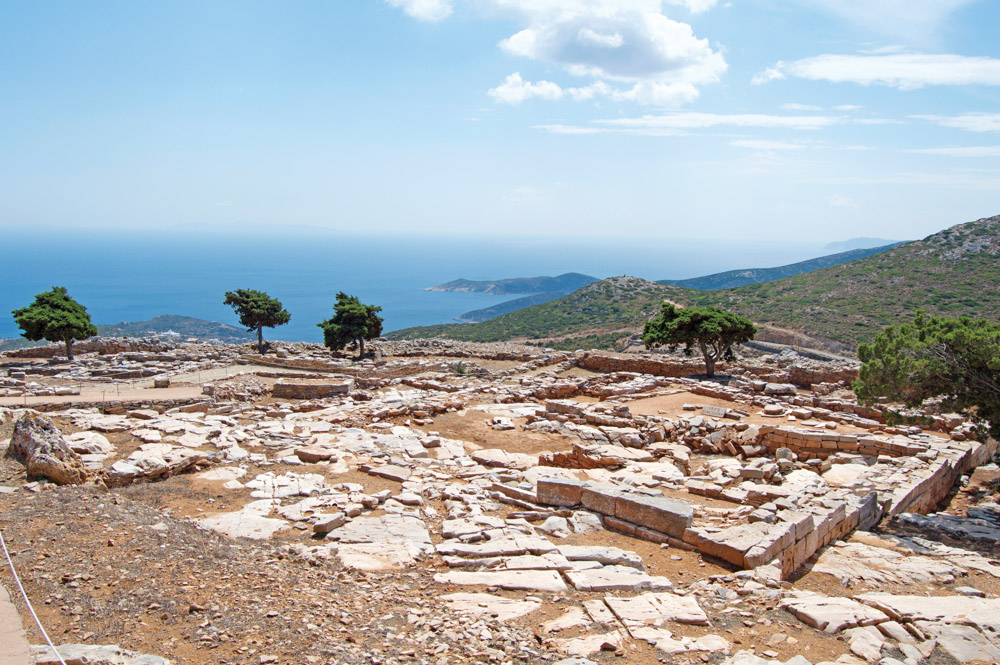
Plan Your Trip
Two resources were especially valuable in planning our trip. The official Sifnos travel website, www.sifnos.gr, offers extensive descriptions and details about virtually every aspect and every location of the island. Even more helpful from the traveler’s perspective was Matt Barrett’s Greece Travel Guide, www.greektravel.com, written by a North Carolina resident who has been traveling to his ancestral homeland since the 1960s and who spends every summer there. It would be difficult to find a more comprehensive source of information. The site is organized, accessible, entertaining, and exhaustive in content. If you are not excited about traveling to Greece after reading Matt Barrett’s website, you should probably just stay home.
— V —
Freelance writer Sandra Kytle Woodward has been a contributing writer to VIE since 2009. Based in Upstate South Carolina, she divides her time between plotting her next big trip and exploring the many back roads and historical markers in her own backyard. Sandra recalls her first travel adventure was an overnight visit to her cousin’s house down the street at the age of four. Since then, she has never missed an opportunity to pack her suitcase and go. “I still recall the excitement of being on my own for the first time, even among people I knew so well,” says Sandra. “Sleeping in a strange bed, eating what they ate, everything was familiar but different. Every time I travel, I experience the same joy of stepping outside my routine and learning more about myself and my place in this extraordinary world!”
Share This Story!
KEEP UP WITH THE LATEST STORIES FROM VIE
















































































































































